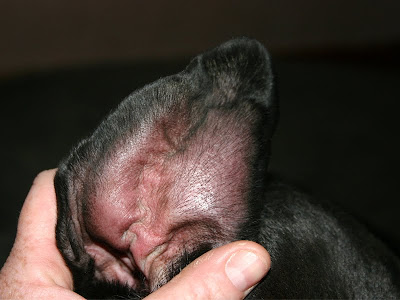Remember the Spelling Bee? Big words are easier to tackle when you understand how they're put together. Veterinary terms are composed the same way. Just like with any other words, the main parts of veterinary terms are a prefix, a root, and a suffix. The difference is that they typically originate from Greek or Latin.
The suffix is the bit that will tell you about what procedure, condition, disease or disorder you're dealing with.
-oma [oma] from Greek - swelling, mass, tumor
This is probably the most despised of all veterinary (and medical) suffixes because it's associated with cancer. What the suffix itself really tells you, though, is that there is a lump or bump. Nothing more.
Not all medical terms that end with -oma mean a death sentence.
For example, a hematoma (hemo - blood) stands for a localized swelling caused by the accumulation of blood due to damage of a blood vessel(s). An ear hematoma is really just a bruise gone wild. Seroma is similar, except it's a pocket of fluid/serum, rather than blood.
A glaucoma is a condition caused by increased pressure in the eye. It's not a good thing but it is not cancer either.
What about the masses and tumors?
What does the word tumor mean anyway? A tumor is an abnormal mass of tissue. That by itself doesn't tell you whether the tumor is benign (mostly harmless) or malignant (cancerous).
A good example of a mostly harmless tumor is a lipoma. Lipoma is a fatty growth which can generally cause problems only when it gets in a way or when it has something else hiding inside it.
Papilloma (papillomatosis) is a wart-like growth, typically caused by a virus.
Some tumors can go either way.
For example, mammary gland tumors in dogs can be both either benign or malignant. Hair follicle tumors (trichoepitheliomas and pilomatricomas) are generally benign, but not always.
Melanomas (tumors of melanin/pigment-producing cells) can be either benign or malignant.
Unfortunately, some tumors are always evil.
For example, a lymphoma (lymphosarcoma), a cancer of lymphocyte cells (a type of white blood cells); Jasmine's best buddy died of that.
Osteosarcoma, a bone cancer, very evil, unfortunately, the most common bone tumor in dogs.
Some -omas are evil, but not all. Before getting a heart attack at the sound of the suffix, find out what exactly you're dealing with.
Other suffixes:
Veterinary Suffixes (-itis)
The suffix is the bit that will tell you about what procedure, condition, disease or disorder you're dealing with.
This is probably the most despised of all veterinary (and medical) suffixes because it's associated with cancer. What the suffix itself really tells you, though, is that there is a lump or bump. Nothing more.
Not all medical terms that end with -oma mean a death sentence.
For example, a hematoma (hemo - blood) stands for a localized swelling caused by the accumulation of blood due to damage of a blood vessel(s). An ear hematoma is really just a bruise gone wild. Seroma is similar, except it's a pocket of fluid/serum, rather than blood.
 |
| Aural hematoma. Image Pet Doctor Mom |
What about the masses and tumors?
What does the word tumor mean anyway? A tumor is an abnormal mass of tissue. That by itself doesn't tell you whether the tumor is benign (mostly harmless) or malignant (cancerous).
A good example of a mostly harmless tumor is a lipoma. Lipoma is a fatty growth which can generally cause problems only when it gets in a way or when it has something else hiding inside it.
Papilloma (papillomatosis) is a wart-like growth, typically caused by a virus.
 |
| Papilloma. Photo Organic Pet Digest |
For example, mammary gland tumors in dogs can be both either benign or malignant. Hair follicle tumors (trichoepitheliomas and pilomatricomas) are generally benign, but not always.
Melanomas (tumors of melanin/pigment-producing cells) can be either benign or malignant.
Unfortunately, some tumors are always evil.
For example, a lymphoma (lymphosarcoma), a cancer of lymphocyte cells (a type of white blood cells); Jasmine's best buddy died of that.
Osteosarcoma, a bone cancer, very evil, unfortunately, the most common bone tumor in dogs.
Some -omas are evil, but not all. Before getting a heart attack at the sound of the suffix, find out what exactly you're dealing with.
Other suffixes:
Veterinary Suffixes (-itis)

Comments
Post a Comment